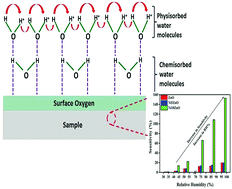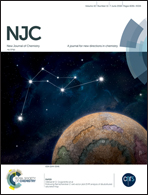Controlled Zn1−xNixO nanostructures for an excellent humidity sensor and a plausible sensing mechanism
Abstract
Here, we report on the chemi-resistive humidity sensing behavior of a Zn1−xNixO nanomaterial synthesized using a wet chemical method. At room temperature, the x = 0.10 sample shows excellent humidity sensitivity of 152% and a response/recovery time of 27/3 s within the 33–97% relative humidity (RH) range. The experimental data observed over the entire range of RH values can be well-fitted to a Freundlich adsorption isotherm model, which reveals two distinct water adsorption regimes. The obtained results suggest that the x = 0.10 sample has the highest adsorption strength. Theoretical humidity detection limits for the x = 0, 0.05 and 0.10 samples are found to be about 7.24% RH, 6.31% RH and 3.71% RH, respectively. The excellent humidity sensing observed using the ZnO and Ni doped ZnO nanostructures is attributed to a Grotthuss mechanism, considering the distribution of available adsorption sites. Therefore, Ni doped ZnO nanostructures synthesized via employing an economical wet chemical technique demonstrate promising capabilities to act as potential candidates for the fabrication of next-generation humidity sensors.



 Please wait while we load your content...
Please wait while we load your content...